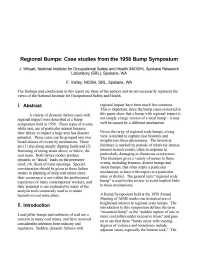Mining Publication: Regional Bumps: Case Studies from the 1958 Bump Symposium
Original creation date: January 2010
A variety of dynamic failure cases with regional impact were described at a bump symposium held in 1958. These types of events, while rare, are of particular interest because their ability to impact a large area has disaster potential. These cases can be grouped into two broad classes of events by mechanism. These are (1) a slip along steeply dipping faults and (2) the fracturing of strong strata above or below the coal seam. Both failure modes produce dynamic or "shock" loads on the perimeter (roof, rib and floor) of mine openings. Special consideration should be given to these failure modes in the planning of deep coal mines, since their occurrence is not within the professional experience of many contemporary workers. In addition, their potential is not evaluated by many of the analysis tools commonly used to evaluate hazards in coal mine plans.
Authors: JK Whyatt, FD Varley
Peer Reviewed Journal Article - January 2010
NIOSHTIC2 Number: 20036372
Trans Soc Min Metal Explor 2010 Jan; 326:101-105
See Also
- Coal Mine Burst Prevention Controls
- Diagnosing and Controlling Moisture-Sensitive Roof in Coal Mines
- A Hybrid Statistical-Analytical Method for assessing Violent Failure in U.S. Coal Mines
- Identification of Areas at Risk for Coal Bursts in Deep Cover Room and Pillar Mines
- Occurrence and Remediation of Coal Mine Bumps: A Historical Review
- Optimum Mine Designs to Minimize Coal Bumps: A Review of Past and Present U.S. Practices
- Refuge Alternatives in Underground Coal Mines
- Remote Methane Sensors
- The Role of Gas Desorption in the Energetic Failure of Coal
- Wireless Mesh Mine Communication System
- Content source: National Institute for Occupational Safety and Health, Mining Program


 ShareCompartir
ShareCompartir
